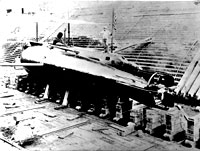 One hundred and eleven years ago today the US Navy accepted its first successful submarine, the USS Holland. The previous November, in New York harbor, the Holland passed the Navy’s tests. She ran for one mile underwater, surfaced, fired a torpedo then dove again and returned underwater to her starting point. Chief Engineer John Lowe, U. S. N. who observed the trials, wrote: “I report my belief, after full examination, that the Holland is a successful and veritable submarine torpedo-boat, capable of making a veritable attack upon the enemy unseen and undetectable, and that, therefore, she is an engine of warfare of terrible potency which the government must necessarily adopt into its service.”
One hundred and eleven years ago today the US Navy accepted its first successful submarine, the USS Holland. The previous November, in New York harbor, the Holland passed the Navy’s tests. She ran for one mile underwater, surfaced, fired a torpedo then dove again and returned underwater to her starting point. Chief Engineer John Lowe, U. S. N. who observed the trials, wrote: “I report my belief, after full examination, that the Holland is a successful and veritable submarine torpedo-boat, capable of making a veritable attack upon the enemy unseen and undetectable, and that, therefore, she is an engine of warfare of terrible potency which the government must necessarily adopt into its service.”
Happy Birthday, U.S. Submarine Force
The submarine was designed and built by John Philip Holland, an Irish engineer. The design was highly innovative for its day and introduced many features still found on modern submarines. It was powered on the surface by an internal combustion engine and underwater by a battery powered electric motor. It used ballast to achieve neutral trim and buoyancy and controlled its depth using diving planes. It had a conning tower, re-loadable torpedo tubes and a deck gun. It did lack, however a functioning periscope. Six more of her type were ordered and built at the Crescent Shipyard in Elizabeth, New Jersey.
Holland also developed the first Royal Navy submarines, the Holland class of which five were built beginning in 1901.
Thanks to Bowsprite for passing the birthday along.
